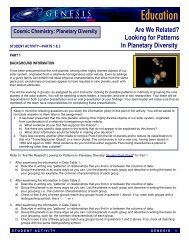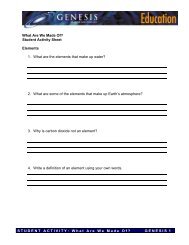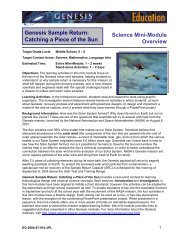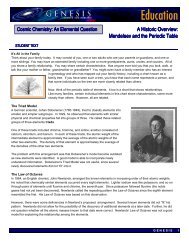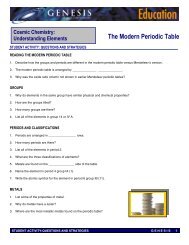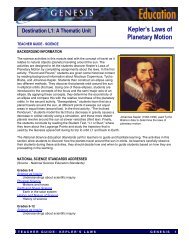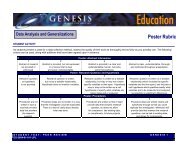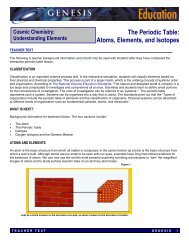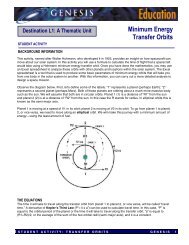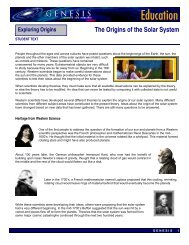Genesis Launch Vehicle: The Delta Rocket - Genesis - NASA
Genesis Launch Vehicle: The Delta Rocket - Genesis - NASA
Genesis Launch Vehicle: The Delta Rocket - Genesis - NASA
You also want an ePaper? Increase the reach of your titles
YUMPU automatically turns print PDFs into web optimized ePapers that Google loves.
Dynamic Design:<br />
<strong>Launch</strong> and Propulsion<br />
<strong>Genesis</strong> <strong>Launch</strong> <strong>Vehicle</strong>:<br />
<strong>The</strong> <strong>Delta</strong> <strong>Rocket</strong><br />
STUDENT TEXT<br />
<strong>The</strong>re are many rockets that have been used to launch vehicles into space.<br />
<strong>The</strong> United States used the Jupiter C to launch its first satellite, called<br />
Explorer I, in 1958. <strong>The</strong> Mercury Redstone launched the first American into<br />
space in 1961. <strong>The</strong> <strong>Delta</strong> scout made its debut in 1960. <strong>The</strong> <strong>Delta</strong> is one of<br />
the most successful rockets in history. It can be configured in several ways<br />
in order to meet the specification of a mission. <strong>The</strong> following details the<br />
launch vehicle used to lift <strong>Genesis</strong> away from the Earth and includes a<br />
history of the famous rocket.<br />
<strong>Delta</strong> II 7326<br />
Watch a video of Kris Walsh and see a model of the launch vehicle for<br />
the <strong>Genesis</strong> spacecraft: the Boeing <strong>Delta</strong> II 7326. <strong>The</strong> number 7326 is a<br />
code that explains a bit of the history about the rocket. <strong>The</strong> first number, in<br />
this case the seven, stands for the fact that the first stage (bottom) of the<br />
<strong>Delta</strong> has been changed seven times. <strong>The</strong> second number, in this case the<br />
three, stands for the numbers of solid rocket boosters that are attached. <strong>The</strong><br />
third number, in this case the two, means that the second stage (middle) has<br />
been changed twice. Finally, the last number, the six, represents the kind of<br />
third stage (top) present in the rocket. This rocket meets the mass and<br />
volume requirements for the <strong>Genesis</strong> spacecraft. <strong>The</strong> 7326 is smaller than<br />
the <strong>Delta</strong> II used by other Discovery missions to date. Table 1 below shows<br />
the launch vehicles used for the first five discovery missions.<br />
Spacecraft mass and launch vehicle used for the first five Discovery<br />
missions. Based on the launch vehicle numbers, what can you tell about the<br />
<strong>Delta</strong> launch vehicles used by these discovery missions<br />
Table 1:<br />
Discovery Mission Spacecraft Mass <strong>Launch</strong> <strong>Vehicle</strong><br />
NEAR 805 kg <strong>Delta</strong> II 7925<br />
Mars Pathfinder 890 kg <strong>Delta</strong> II 7925<br />
Lunar Prospector 1,896 kg Athena II<br />
Stardust 380 kg <strong>Delta</strong> II 7425<br />
<strong>Genesis</strong> 414 kg <strong>Delta</strong> II 7326<br />
<strong>The</strong> first stage is powered by the Boeing <strong>Rocket</strong>dyne-built RS-27A main engine, which is ignited at launch and burns for<br />
about four minutes. <strong>The</strong> first stage also contains three solid fuel boosters with ground lit Graphite Epoxy Strap-on Motors<br />
(GEM) that are ignited at liftoff and burn for about 66 seconds before they are separated from the vehicle. <strong>The</strong> liquid fuel in<br />
the first stage is kerosene and liquid oxygen. After the first stage burns for four minutes, a liquid-propellant engine that<br />
powers the second stage of the <strong>Delta</strong> II rocket is fired. <strong>The</strong> second stage can be turned on and off in order to orient the third<br />
stage into the proper orbit. For the <strong>Genesis</strong> spacecraft, the third stage contains a STAR 37FM motor. Once the second<br />
stage separates, the third stage solid rocket is fired and does not stop firing until the propellant runs out. After the spacecraft<br />
has been oriented into the proper trajectory the third stage is separated from the spacecraft.<br />
STUDENT TE XT: THE DELTA RO C K ET G E NES I S 1
<strong>The</strong> image at left shows the three stages of the <strong>Delta</strong> II rocket, as it appears<br />
when mated with the <strong>Genesis</strong> spacecraft. <strong>The</strong> <strong>Genesis</strong> spacecraft sits on top of<br />
the third stage, which includes 9.5-foot fairings. <strong>The</strong> solar panels are folded<br />
inward during the time in which it is in the rocket. Note that the fairings protect<br />
the <strong>Genesis</strong> spacecraft as well as the second and third stage of the rocket.<br />
<strong>The</strong> <strong>Genesis</strong> spacecraft is launched from Cape Canaveral Air Force Station on<br />
launch pad 17 A. This launch pad is where all of the <strong>Delta</strong> rockets are launched.<br />
A lot of history has happened at this launch pad, according to author L.B.<br />
Taylor; visitors can see impressions of rockets on the north side of the pad.<br />
Near the launch pad there is an image of the red bellied woodpecker with a<br />
cross beside it, symbolizing a perfect launch.<br />
History of the <strong>Delta</strong> <strong>Rocket</strong><br />
<strong>The</strong> <strong>Delta</strong> rocket was derived from the Thor rockets used by <strong>NASA</strong> in the late 1950’s. <strong>The</strong> fourth modification to the Thor<br />
rocket caused <strong>NASA</strong> Director of Spacecraft and Flight Missions Milton Rosen to refer to the rocket with the Greek letter<br />
<strong>Delta</strong>. <strong>The</strong> name was officially adopted in January of 1959. In April of that same year <strong>NASA</strong> signed its first launch vehicle<br />
contract with Douglas Aircraft Company for 12 <strong>Delta</strong> <strong>Rocket</strong>s.<br />
<strong>The</strong> first <strong>Delta</strong> launch carrying the Echo Passive Communications Satellite<br />
failed on May 13, 1960 because the third stage did not ignite. However, the<br />
next 22 launches were successful. <strong>The</strong> first of these was the <strong>Delta</strong> 2, which<br />
carried the Echo I satellite into orbit on August 12, 1960. It reflected a radio<br />
message from President Eisenhower across the Nation, demonstrating the<br />
feasibility of global radio communications via satellites. <strong>The</strong> image at left<br />
shows technicians as they examine the Echo satellite payload. <strong>The</strong> 26-inch<br />
diameter magnesium sphere contains a balloon, which was launched into<br />
orbit, where it was released and inflated. <strong>The</strong> Echo I had a diameter of 30.48<br />
meters and was the largest satellite launched at the time. Because it was so<br />
bright in the night sky, it was probably seen by more people than any other<br />
human made object. At the time, the newspapers printed the times that this<br />
satellite could be seen. In 1961, Belgian physicist, Barcel Nicolet studied the<br />
<strong>The</strong> Echo I satellite was launched in<br />
Echo satellite so closely that he could calculate the drag of the thin<br />
1960. atmosphere in which the satellite was traveling. He was then able to<br />
calculate the density of this region known as the heliosphere<br />
Other notable early launches included the <strong>Delta</strong> 8, which carried the first Orbiting<br />
Solar Observatory (OSO) on March 7, 1962. This was the first time the sun was<br />
studied beyond Earth’s atmosphere. <strong>The</strong> observatory, shown at right, helped<br />
scientists study the sun in the ultraviolet, x-ray and gamma regions of the<br />
spectrum.<br />
<strong>The</strong> Ariel 1 was the first<br />
international satellite.<br />
Sun sensors connected to servo-feedback<br />
systems on the upper "sail" portion were<br />
designed to keep the pointed instruments<br />
aimed toward the center of the sun. <strong>The</strong> lower<br />
spinning portion carried instruments and<br />
<strong>The</strong> Orbiting Solar Observatory was the<br />
rotated once every two seconds, allowing first time we could study the sun above<br />
those instruments to scan the solar disk and the atmosphere.<br />
atmosphere. <strong>The</strong> OSO had three protruding<br />
arms that extended after deployment. Among many of the discoveries made from the<br />
observations by the battery of instruments on OSO was that the sun's corona had<br />
openings, now called coronal holes, which were interpreted as huge fast-moving<br />
bubbles rising through the corona.<br />
STUD ENT TE XT: TH E DELTA RO CK ET<br />
G E N ESI S<br />
2
<strong>Delta</strong> 9, launched on April 26, 1962, put the Ariel 1 into orbit. It was the first international satellite representing the efforts of<br />
the United States and the United Kingdom. This satellite studied the Earth’s ionosphere, the part of the Earth's atmosphere<br />
in which ionization of atmospheric gases affects the propagation of radio waves,<br />
and extends from about 30 miles (50 kilometers) to the exosphere.<br />
Although the Echo I could be used to reflect radio waves, the reflection was too<br />
weak to be used for anything except to demonstrate that it could be done. <strong>Delta</strong><br />
11 launched the first television satellite on July 10, 1962. <strong>The</strong> Telstar I was able<br />
to receive signals and amplify them before sending them back to Earth. <strong>The</strong> first<br />
transmission from Telstar I was a live television program that was transmitted<br />
from Maine to stations in England and France. From this point on<br />
communications became truly global.<br />
Table 2 shows the various models of <strong>Delta</strong> rockets, the year they were<br />
introduced and the payload capacity into either Low Earth Orbit (LEO) or<br />
Geosynchronous Earth Orbit (GEO). During the 1970’s the <strong>Delta</strong> was famous<br />
for launching the Pioneer space probes, which <strong>NASA</strong> used to explore the outer<br />
planets of our solar system.<br />
<strong>The</strong> Telstar I was the first<br />
communications satellite.<br />
Over the years the <strong>Delta</strong> rockets have become larger and the payload capacity has increased. Solid rocket boosters were<br />
strapped onto the first stage to allow for more propellant to be used. Larger fuel tanks, an improved main engine, the<br />
addition of advanced guidance systems and the additional upper stages were all changes that led to this increase in size<br />
and payload capacity. In May of 1984, <strong>NASA</strong> transferred the <strong>Delta</strong> to a private company and by November of that year it<br />
was thought that the last <strong>Delta</strong> had flown. <strong>The</strong> space shuttle was to take over the task of transporting all of <strong>NASA</strong>’s mediumto-heavy<br />
satellites into orbit. <strong>The</strong> Challenger explosion in 1986 changed everything. After the accident, the shuttle fleet was<br />
grounded, opening the door for the <strong>Delta</strong> to be used once again. As a result, the more powerful <strong>Delta</strong> II, which can be used<br />
as a two- or three-stage rocket, was produced in 1989. <strong>The</strong> three-stage <strong>Delta</strong> II is used to launch spacecraft into<br />
geosynchronous orbit or for deep space missions.<br />
Table 2: <strong>Delta</strong> <strong>Rocket</strong>s 1959-2002<br />
<strong>Delta</strong> Model Introduction Year Payload Capacity into Low Earth Orbit<br />
(LEO) or Geosynchronous Earth Orbit<br />
(GEO) in kilograms<br />
Original 1959 45.36 (LEO)<br />
A 1962-1972 68.04 (LEO)<br />
C 1963 544.31 (GEO)<br />
D 1964 453.59 (LEO)<br />
E 1965 Over 544.31 (GEO)<br />
J 1968 544.31 (GEO)<br />
M 1969 635.03 (GEO)<br />
M6 1970 635.03(GEO)<br />
900 series 1972 1678.29 (LEO)<br />
2910 1974 1,995.81 (LEO)<br />
3914 1975 929.86 (GEO)<br />
3910/PAM D 1980 1,088.62 (GEO)<br />
3920/PAM-D 1982 1,270.06 (GEO)<br />
<strong>Delta</strong> II 7928 1990 1,814.37 (GEO)<br />
<strong>Delta</strong> III 1998 3,810.18 (GEO)<br />
<strong>Delta</strong> IV (heavy) 2002 23,042.49 (LEO), 13,585.09 (GEO)<br />
Currently under development are the <strong>Delta</strong> IV medium to heavy rockets. <strong>The</strong> United States Airforce has ordered 19 Boeing<br />
<strong>Delta</strong> IV launches. <strong>The</strong> first commercial <strong>Delta</strong> IV launch is planned for the year 2001.<br />
<strong>The</strong> <strong>Delta</strong> rocket has been a very reliable delivery system since 1960. To date there have been 283 launches of the <strong>Delta</strong><br />
<strong>Rocket</strong>. Table 3 shows an overview of the launch history of the <strong>Delta</strong> rocket.<br />
STUD ENT TE XT: TH E DELTA RO CK ET<br />
G E N ESI S<br />
3
Table 3: Successes and Failures of all <strong>Delta</strong> Series <strong>Rocket</strong>s 1959- Present<br />
Year Success Failure<br />
1960-1969 69 5<br />
1970-1979 70 5<br />
1980-1989 38 1<br />
1990-1999 81 3<br />
2000-2001 9 0<br />
<strong>The</strong> <strong>Delta</strong> II has launched 93 payloads into orbit with only one failure and one that was partially successful.<br />
Countdown To <strong>Launch</strong><br />
10, 9, 8, 7, 6, 5, 4, 3, 2, 1…Most people think of a launch as the ten seconds before liftoff. Getting a rocket off the ground is<br />
more than lighting the wick, standing back, and watching. More than a thousand people around the world are involved in the<br />
launch months or years prior to liftoff. Listen to audio files of Boeing Mission Integration Manager Kris Walsh explaining both<br />
the launch campaign and the role of the Mission Integration Manager. <strong>The</strong> launch campaign starts 45 days before<br />
launch with a pre-vehicle on-stand review. This is a four-to-six hour meeting in which all of the aspects of the building of the<br />
rocket and mission-specific analyses are discussed between Boeing, the Jet Propulsion Laboratory, and Lockheed Martin<br />
Astronautics. At the end of this meeting the three organizations concur that the vehicle is ready to go onto the stand. <strong>The</strong>n,<br />
14 days before launch, a similar review is held in which a decision is made to put spacecraft onto the rocket. Five days prior<br />
to launch, a flight readiness review meeting is held in which Boeing, <strong>NASA</strong> Kennedy Space Center, the Jet Propulsion<br />
Laboratory, Lockheed Martin Astronautics, and the Air Force range, <strong>NASA</strong> headquarters, and mission assurance staff<br />
members review the entire process again. <strong>The</strong>n a poll is taken and if everyone agrees, fuel is loaded onto the second stage.<br />
This is an important decision, since once fuel is loaded, the rocket must be launched within the next 35 days, or the second<br />
stage will need to be taken down.<br />
JPL/LMA<br />
<strong>The</strong> countdown normally begins a day or two before launch. Two days prior to launch,<br />
a mission rehearsal is conducted in which a countdown is simulated with responses and<br />
use of equipment in the mission director’s center. A launch readiness review is<br />
conducted in which the weather, range, and other issues with the vehicle and spacecraft<br />
are addressed prior to a “go for launch.” <strong>The</strong> terminal phase of the countdown, which is<br />
familiar to most people, begins several hours before launch. <strong>The</strong> events that take place<br />
during a countdown are critical.<br />
Since no job can be rushed, if<br />
something needs to be reviewed<br />
or double checked, a hold is put<br />
on the countdown until it has<br />
been taken care of. Four hours<br />
prior to launch, everyone is on<br />
console when a very standard<br />
countdown begins. Following<br />
ignition and liftoff, the rocket<br />
Lockheed Martin Astronautics<br />
clears the tower in just eight<br />
workers assemble the <strong>Genesis</strong><br />
seconds. After this successful<br />
spacecraft.<br />
launch, the Boeing team did not<br />
cheer until the <strong>Genesis</strong><br />
spacecraft was in its perfect orbit on its way to L1, the location<br />
where <strong>Genesis</strong> will collect solar wind.<br />
<strong>NASA</strong><br />
Let’s look at what happens before the terminal phase. <strong>The</strong> various<br />
Workers help guide the crane moving the spacecraft<br />
systems and subsystems of the rocket and spacecraft are<br />
above the upper stage of the <strong>Delta</strong> rocket.<br />
assembled in different locations in the United States. <strong>The</strong> <strong>Genesis</strong><br />
spacecraft was built at Lockheed Martin Astronautics located in<br />
Denver, Colorado. Once the spacecraft and systems for the rocket are built, they are flown into Kennedy Space Center on<br />
STUD ENT TE XT: TH E DELTA RO CK ET<br />
G E N ESI S<br />
4
planes that land on the skid strip, which is a runway named for early missiles that landed on skids instead of wheels. Find<br />
the skid strip and <strong>Launch</strong> Complex 17 on a map of Kennedy Space Center on page 6 of this student text.<br />
During the last two weeks, the exact weight of <strong>Genesis</strong> is measured so that the third stage can be balanced. <strong>The</strong><br />
spacecraft is then mated to the third stage. <strong>The</strong> spacecraft, in the third stage, is transported to the rocket at night,<br />
moving no more than five miles per hour. <strong>Genesis</strong> is “under the hook” by 5:00 AM. <strong>The</strong> spacecraft in the can is lifted to a<br />
white room in which it stays for about 4 hours so any contamination in the white room can be filtered out. <strong>The</strong> spacecraft is<br />
then integrated, the canned segments are taken apart and electrical connections are made.<br />
Finally the fairings are installed. <strong>The</strong> fairings have doors so that the spacecraft can be accessed. <strong>The</strong>re are blankets<br />
attached to the fairings that have to be tied back because the <strong>Genesis</strong> spacecraft comes very close to the fairings. View<br />
images of technicians working on the <strong>Genesis</strong> spacecraft at:<br />
http://www.genesismission.org/mission/viewinggallery/index.html<br />
<strong>NASA</strong><br />
<strong>The</strong> location to be used to launch <strong>Genesis</strong> is<br />
Complex 17, a large, fenced area of several<br />
acres. Both the <strong>Delta</strong> II and <strong>Delta</strong> III rockets<br />
are launched from this complex. <strong>The</strong>re are<br />
two launch pads (17A and 17B), a<br />
blockhouse, ready room, shops and other<br />
facilities needed to prepare service and<br />
launch the rockets. <strong>Genesis</strong> is launched on<br />
pad 17 A. <strong>The</strong> pads are concrete-hard<br />
stands.<br />
<strong>Launch</strong> Complex 17<br />
<strong>The</strong> gantry is the highly visible service<br />
structure located next to the launch pad. It contains large cranes, which are<br />
used to erect the rocket. On the opposite side of the pad from the gantry is<br />
the umbilical tower. This tower has lines that are used to load propellant and<br />
other components into the rocket.<br />
After fueling is completed and final<br />
systems checks have been made, a<br />
specialist in charge will give<br />
permission to “go” for launch. At this<br />
point the countdown is completely<br />
automated. <strong>The</strong>re is no person that<br />
pushes the launch button. If trouble<br />
develops, even at a fraction of a<br />
second before launch, the computer<br />
senses it and the engines are shut<br />
down. During a successful launch the<br />
temperature on the pad can be over<br />
1900 degrees Celsius (3,452 degrees<br />
Farenheit). <strong>The</strong>re are special heat<br />
<strong>The</strong> <strong>Genesis</strong> spacecraft being encapsulated resistant surfaces placed around<br />
inside the fairing.<br />
equipment for protection. Thousands<br />
of gallons of water are also poured<br />
onto the launch pad to help sound abatement and to cool it down. <strong>The</strong> water dumped<br />
on the pad is momentarily turned to steam which is invisible. <strong>The</strong> force of the rocket<br />
exhausts blasts it away into the cooler air around the pad, causing the steam to<br />
condense as small water droplets, forming the familiar white cloud.<br />
<strong>The</strong> first stage of a <strong>Delta</strong> II rocket is<br />
lifted up the gantry.<br />
<strong>NASA</strong> <strong>NASA</strong><br />
<strong>Genesis</strong> will employ a single boost-to-orbit trajectory with a flight azimuth of 95 degrees. At 35.6 seconds after launch, the<br />
rocket will reach Mach 1. At just over one minute into the launch, the solid motors burn out and are separated from the<br />
rocket. <strong>The</strong> next significant event is main engine cutoff, which occurs at four minutes after launch. Eight seconds later, the<br />
STUDENT TEXT: THE DELTA ROCKET<br />
GENESIS<br />
5
first and second stage then separate, followed by the ignition of the second stage. <strong>The</strong> payload fairing is then jettisoned at<br />
the five-minute mark, followed by the second engine cutoff five minutes later. After the second stage is restarted, the third<br />
stage is separated from the second. <strong>The</strong> third stage burn places the spacecraft into the desired orbit.<br />
STUDENT TEXT: THE DELTA ROCKET<br />
GENESIS<br />
6



